Charleston, South Carolina is consistently voted as one of the top destinations to visit in the United States. Travelers are enticed by this East Coast city’s broad-based appeal, showcasing Lowcountry cuisine, cobblestone streets with architectural treasures, outstanding accommodations, diverse shopping opportunities, a moderate climate, and a rich history that spans multiple generations.
To capture a small portion of the region’s history, I visited a cross section of popular tourist attractions. Each offered an opportunity to see why people have been drawn to this region for centuries. From the colonists seeking religious freedom to tourists visiting historic houses of worship, Charleston’s cultural values continue to resonate with those who visit. With just a couple of days in town and layers and layers of history to explore, I narrowed my focus to samples of plantation life, two historic religious buildings, a centrally located museum, and several military sites.

SOUTHERN CULTURE—PLANTATION LIFE
Plantations were an integral part of Charleston’s history during the antebellum era. By the 1850s, South Carolina had become the richest state in the United States due to its plantation-based economy. Up until the Civil War, slaves farmed enormous tracts of land owned by wealthy entrepreneurs. When slavery was abolished, Charleston’s economy suffered tremendously.
To gain an understanding of how plantations impacted Charleston in the 18th and 19th centuries, I added a plantation to my list of places to visit. I quickly learned that I had several options. My top choice was the Magnolia Plantation and Garden, the oldest public tourist site in the Lowcountry and the oldest public garden in the United States. On the way back to town, we made an unplanned stop at nearby Drayton Hall.
Magnolia Plantation and Gardens
Thomas and Ann Drayton established the Magnolia Plantation in 1676. Hundreds of years later, the current owners trace their heritage to this couple. Drayton descendants fought against the British during the Revolutionary War and sided with the Confederates during the Civil War.
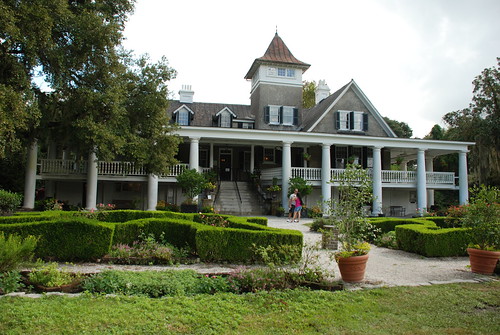
Home at Magnolia Plantation
The history of the gardens is infused with a bit of romance. In the 1840s, the Reverend John Grimké Drayton expanded the formal garden and created an English inspired informal garden from the garden’s original Louis XIV style. It was Drayton’s hope that the gardens would make his Philadelphia-born wife more comfortable in South Carolina. Many sources attribute the introduction of planting azaleas in American gardens to Drayton. Every year, visitors come to see the azaleas blooming in the spring.
In the aftermath of the Civil War, when the family lost its immense wealth, Drayton capitalized on the discovery of phosphate rock with a high concentration of lime in the Ashley River area. Drayton sold part of his land and also leased some of the mining rights to others. The strip mining altered the original grounds of the Magnolia Plantation.
Drayton also used his garden, an amazing natural resource, as a tourist attraction. Today, visitors can step back in time by taking guided and self-guided tours on this former plantation that has been placed on the National Register of Historic Places by the Department of the Interior. Numerous touring options are available: The Nature Train, The House Tour, Slavery to Freedom, and the Nature Boar, or simply follow the self-guided tour map.

A Garden at Magnolia Plantation
We chose the 45-minute narrated nature tour. Within no time, our tram was straddling alongside the glossy, green colored Ravenswood Pond as it weaved its way through a heavily wooded, majestic forest with multiple shades of green. Broad based trees layered with lacey moss lined the roadway. The tour guide periodically pointed out different species—Virginia live oaks, magnolias, cypress, and palmettos—to name a few.

Bridge near pond at Magnolia Plantation
In this swamp ecosystem, I captured the image of an American alligator resting on a platform as blue herons flew overhead. While I didn’t see any snakes, our guide let us know that six different types of venomous snakes slithered on the property. Even though I was advised that it was unlikely to encounter a water moccasin, cottonmouth, coral, or rattlesnake, I was not eager to venture on any of the bridges that connected one piece of land to another. I was content to admire the landscape where “humanity and nature are in harmony.”
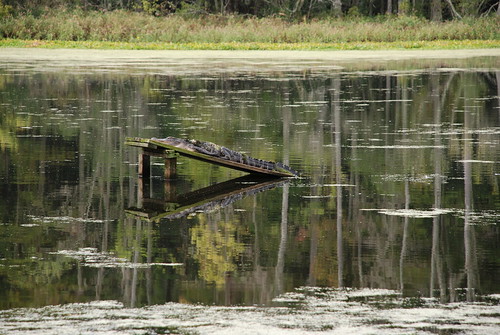
Alligator in Ravenswood Pond at Magnolia Plantation
As we passed by former slave cabins, my imagination roamed. I thought about the slaves who once cleared this area for farming and then later maintained the crops. Countless numbers must have died at the hands of predators and been adversely affected by heat stroke and diseases carried by mosquitoes. If time were not a premium, we would have also taken the Slavery to Freedom tour to learn more about the slaves who once lived on the plantation.
Instead, we explored a small portion of the grounds by foot. We came upon an authentic reproduction of the Julianna, a plantation flat, used to carry produce down the river to Charleston Landing about 10 miles away. This type of vessel utilized the natural tides to transport tons of produce to the marketplace.
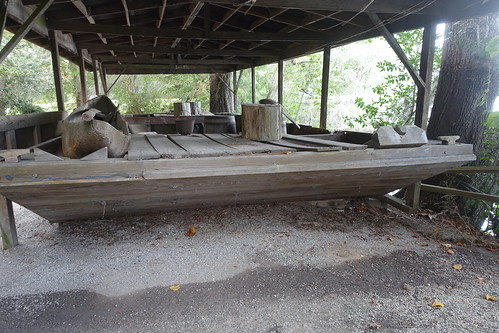
Julianna, a plantation flat reproduction
Another marker designated the spot where early 20th century paddle wheel steamers would transport tourists from Charleston in about an hour. Before improvements were made to encourage land transportation, it would take about three hours to travel by carriage on the local roadway. This was also the location where General Cornwallis’ troops crossed the Ashley River in 1779.
While exploring the grounds, we overheard a tour guide recommend nearby Drayton Hall. We chose to leave a bit earlier than originally planned from the Magnolia Plantation so that we could see another place on the way back to Charleston. Visitors who want to maximize their time on the property by participating in all of the guided tours and walking through the gardens should plan on spending at least four hours at the plantation.
Drayton Hall
Raindrops cascaded on our windshield as we entered the driveway leading to Drayton Hall. The main draw is an original antebellum house built in the style of an English country estate, dating to 1747. John, the third son of Thomas Drayton, Jr., and Ann Drayton purchased the land and arranged for the building of this home.

Drayton Hall Home
Upon entering, visitors go back to a time when people lived without modern conveniences such as electricity, refrigeration, running water, and inside plumbing. While a few renovations have been made during the seven generations when the Drayton descendants resided in the home and since 1974, when the National Trust for Preservation started overseeing the property, the home remains an architectural gem from the mid 18th century. Even though the Union soldiers burned almost all of the other major properties in the area during the course of the war, it is believed by some that Drayton Hall was spared since the building had been used as a smallpox and cholera hospital.

Inside Drayton Hall Museum
The grounds include one of the oldest documented African American cemeteries in America, several structures with excellent signage that describes key historical points as well as architectural details, and a small, modern museum with artifacts from the 18th and 19th centuries. Samples of ornate furniture and kitchenware are on display. Posted on one wall, a detailed family tree shares pertinent facts about the Drayton family.
Some of the buildings were used after the Emancipation, when mining became the prominent industry. Individuals seeking a better understanding of the slaves who lived and worked in the area will find this place a worthwhile stop.
RELIGIOUS INSTITUTIONS
Kahal Kadosh Beth Elohim and the Coming Street Cemetery
Decades ago, I read about the Sephardic Jews who prospered in South Carolina where the colonial charter mandated religious freedom. The Charleston Jews founded a congregation in 1749, the oldest synagogue in continuous use in the United States.
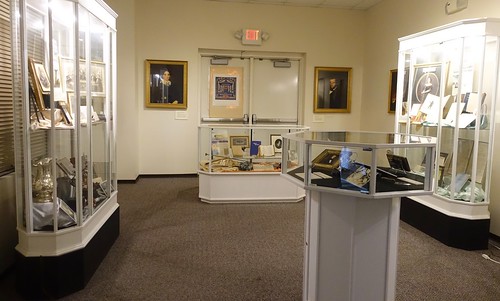
Kahal Kodesh Beth Elohim Museum
Jewish historians oftentimes site Charleston as the birthplace of Reform Judaism in the United States. In 1840, this synagogue was the first to introduce music into its religious service by installing an organ in the sanctuary.
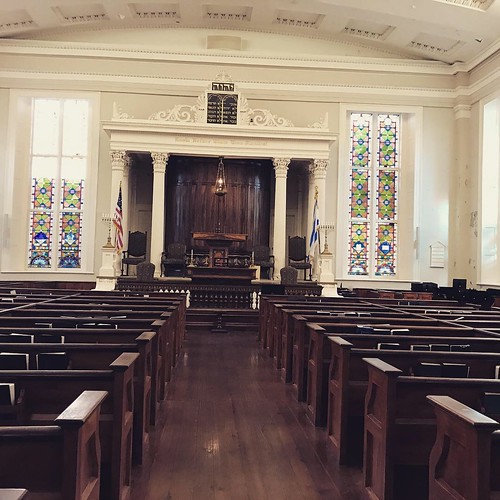
Kahla Kadosh Beth Elohim
To learn more about the community’s fascinating history and culture, I recommend visiting the synagogue’s website to arrange a tour of the building and the Coming Street Cemetery. The cemetery is the oldest surviving Jewish cemetery in the South, with gravestones predating the Revolutionary War.
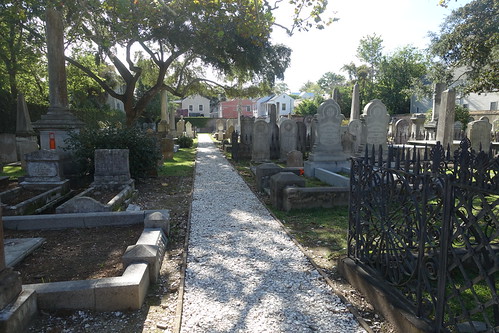
The Coming Street Cemetery
St. Michael’s Episcopal Church
On Charleston’s famous Four Corners of Law, the town’s oldest religious structure stands proudly. Three other historic buildings—the City Hall, the County Courthouse and the United States Post Office and Federal Courthouse—offer prime photo opportunities as well as tidbits of local history. The original bells, chandelier, and organ were imported from England.
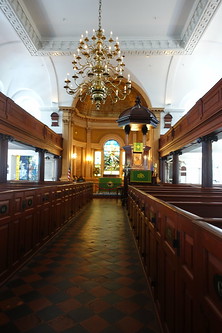
Inside St Michael's Episcopal Church
While most of the city’s buildings were destroyed during the Great Fire of 1861, the 18th century church remains. Our city tour guide mentioned that during the Civil War, the church was painted black to make it less conspicuous to Union gunners. In Very Charleston: A Celebration of History, Culture, and Lowcountry Charm, it states that "the steeple was painted black during the Revolutionary War so it couldn't be used as a target, but the British said it became more conspicuous." The church is open to the public and its website includes background information about the history of the building.
THE OLD EXCHANGE AND PROVOST DUNGEON
There are countless buildings in Charleston that represent different parts of history. The Old Exchange and Provost Dungeon illustrates how one building can tell many stories and be a survivor of both earthquakes and wars. Prior to the Revolutionary War, Charles Town was the fourth largest city in North America, and South Carolina was acknowledged to be the wealthiest colony. In 1771, the Exchange and Custom House became the new economic, social, and cultural center. It was a place where merchants bartered and goods were stored.

Inside Old Exchange
Five years later, on the steps of this building, the Declaration of Independence was read aloud to an audience of South Carolinians. The British turned the building into a military prison in 1780. Until 1782, captured American traitors were oftentimes jailed here. Charles Town was renamed Charleston in 1783 and a city hall was placed on the upper floor of the building. The United States Constitution was debated, and later ratified, in the Great Hall on the second floor in 1788. After George Washington became the first president, he visited the thirteen states. In Charleston, the president’s visit was celebrated at the Exchange.
In 1913, Congress deeded the property to the Rebecca Motte Chapter of the Daughters of the American Revolution and the State of South Carolina. During WWI and WWII, the structure was repurposed as a military headquarters. In1981, the public was able to enjoy the renovated building’s rich history when it was turned into a museum.
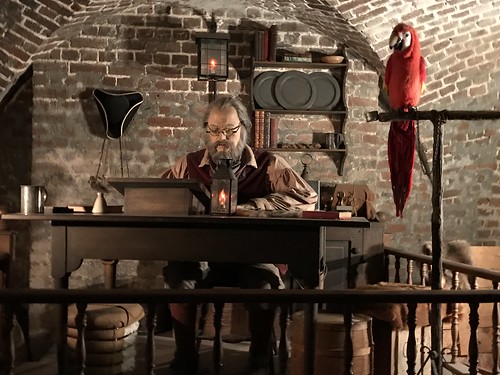
Inside Old Exchange Dungeon
Revolutionary War buffs and history lovers can spend hours reading the signs and admiring the artifacts, diagrams, and photos that retell the building’s history. Don’t forget to venture into the basement to view the dungeon and prison exhibits.
MILITARY HISTORY
Fort Moultrie and Fort Sumter
Many American are aware that the opening shots of the Civil War were fired at Fort Sumter. After only 34 hours of shelling, the Union forces surrendered and the Confederates gained control of the fort. It would take several years of intense fighting before the Union was able to regain control. This significant American history site was near the top of my list of historical places to see. An unexpected coastal storm, which closed the fort, prevented our visit. We could only gaze at the island fort from a distance.
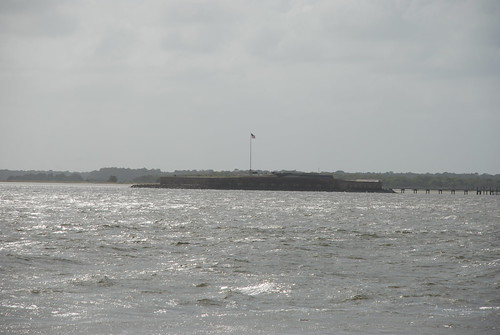
Fort Sumter
Despite an impending tropical storm, we were able to visit most of Fort Moultrie’s outdoor exhibits and the small museum inside the visitor center. Two centuries of coastal defense are illustrated in five distinct sections of the fort, ranging from the Revolutionary War era through World War II.
At this site, a flag with only 24 stars flies in recognition of the soldier-author Edgar Allan Poe, who was once a gunsmith at Fort Moultrie. I recommend looking at the park service brochure before touring because the exhibits representing different points in time are not arranged in chronological order.
American colonists were able to defend the harbor by using spongy palmetto-log walls filled with sand spaces. These flexible logs deflected Admiral Peter Parker’s cannon balls and prevented his fleet of nine British ships from entering Charleston’s harbor. Colonel William Moultrie’s return fire, including the British ships’ own cannon balls, caused Parker and several other ships to withdraw. This major victory is the source of South Carolina’s nickname, “The Palmetto State.”
In the late 18th century, Fort Moultrie II, a five-sided earthwork fort, was constructed to provide fortification for the coastline. Charleston was one of 16 American ports to receive a new national defense system. Weapons are on display from this time period. Slaves from nearby plantations constructed Fort Moultrie I and II.
A sturdier brick fort, Moultrie III, was erected after the 1804 hurricane. Skilled mason workers created the improved walls. Cannons from this time period are on display.
At the beginning of the Civil War, the Union abandoned Fort Moultrie III and moved to the better-positioned Fort Sumter, which was subsequently captured. The Confederate troops held control over both strategic positions until the end of the war.
On the Cannon Walk, one can see cannons from the Civil War to the 20th century. The 50,000-pound Rodman gun required a series of pulleys, blocks and rollers to move.

Fort Moultrie Harbor Defense 1873-1898
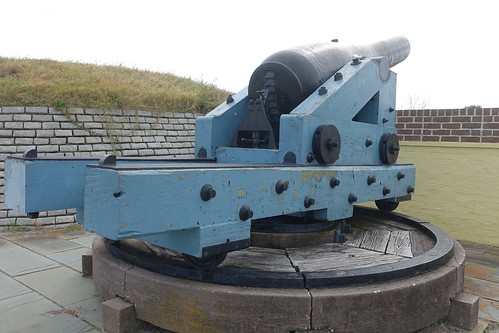
Fort Moultrie Civil War Cannon

Fort Moultrie Harbor Defense 1809-1860
The demolished fort needed to be rebuilt once again. New technology and resources were used throughout the island to protect the region. In response to the Spanish-American War, the Endicott System battery was installed with rapid-fire weapons and electrically controlled minefields, combined with 24-hour surveillance of the coast. The Battery Jasper, a concrete and steel gun deck, was named after the Revolutionary War defender of the palmetto log fort.
The last stage of improvements was put into place during World War II. Anti-Motor Torpedo Boat Batteries were installed on top of, and in front of, the Battery Jasper. An underground Harbor Entrance Control Post and the Harbor Defense Command Post were also added. A stairway leads to concealed rooms.

Fort Moultrie Radio Room
Inside the park service building, visitors can learn more about the history of the fort and also view small exhibits focusing on the Women’s Army Corps and Africa & Enslavement.
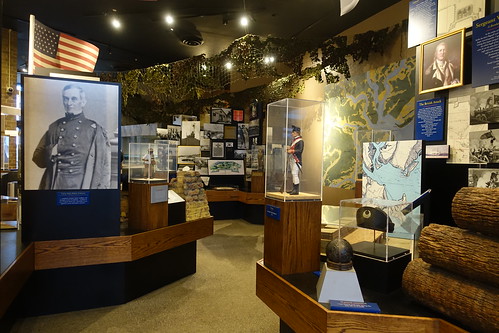
Fort Moultrie Exhibits
Charleston Light—The Last of its Kind
By happenstance, we came upon the last major lighthouse built in the United States. This odd shaped 162.5 foot aluminum-sided structure caught my attention as we were driving away from the fort. The three-sided building was designed in the 1960s to tolerate winds up to 125 miles an hour. The lighthouse emits two flashes of light every 30 seconds and can be seen from 27 miles off shore.
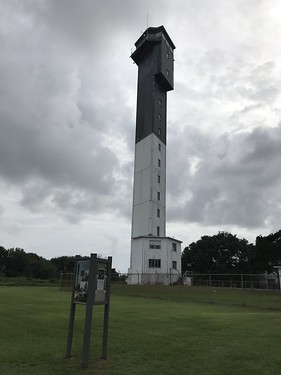
US Coast Guard Historic District Lighthouse
Patriot’s Point Naval & Maritime Museum
Travelers always need to be flexible. When we were unable to visit Fort Sumter, we immediately created Plan B. We used our allotted time for the cancelled Fort Sumter boat and land tour to explore the Patriot Points’ attractions—the USS Yorktown, the USS Laffey, the Clamagore Submarine, and the Vietnam Experience. Our admission ticket offered access to all of these places.
Due to the intense heat and high humidity our visits to the Laffey and Clamagore were abbreviated. A disruptive downpour interfered with our seeing the entire Vietnam exhibit.
USS Yorktown
The USS Yorktown was a “fighting lady of World War II” that was named for the carrier Yorktown that was lost at the Battle of Midway. On board the ship, we visited a Medal of Honor exhibit that showcased recipients. Surprisingly, there are time restrictions for the recommendations as well as a time period for the reward to be presented. The youngest recipient stood out from the rest. William “Willie” Johnston was only 12 years old when he received the honor in 1863 for not throwing away his drum when all of his fellow soldiers discarded their equipment during a major retreat from the battlefield.

Patriots Point Medal of Honor Exhibit
While nowhere as large as the USS Midway in San Diego, this navy ship provides both an excellent understanding of life aboard an aircraft carrier and allows an opportunity to view dozens of airplanes and learn about their history from detailed descriptions.
A small inside exhibit reminds visitors of Project Apollo. Focal points include the 1967 tragedy when three astronauts were killed in an accident that destroyed their command module, and the joy associated with Apollo 8’s astronauts’ ability to see the far side of the moon. The USS Yorktown retrieved this spacecraft from the ocean.
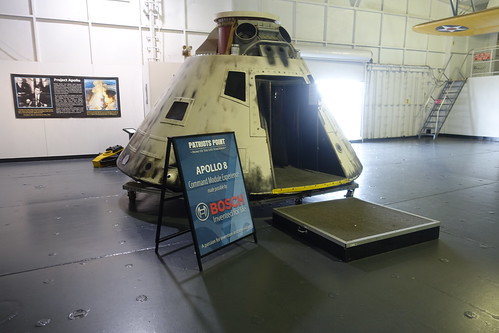
Patriots Point Apollo 8
USS Laffey Destroyer
This ship (DD-724), an Allen M. Sumner class destroyer, shared the same name as the USS Laffey DD-459, a ship that sunk in 1942 during the naval battle of Guadalcanal. Fifty-nine men were lost and another 116 were wounded. Interestingly, both ships were named after Seaman Bartlett Laffey, a Civil War Medal of Honor Recipient.
Inside the ship, an exhibit allows visitors to relive the 1945 attack by Japanese aircraft—both conventional bombers and kamikazes. Even though the USS Laffey had four bomb hits and six kamikaze impacts, the ship didn’t sink. It was able to return to Seattle for repairs. During World War II, thousands of American and British sailors were killed during kamikaze attacks and an unverified number of ships sunk.
In 1981, the ship became an exhibit at Patriots Point and was named a National Historic Landmark in 1986.
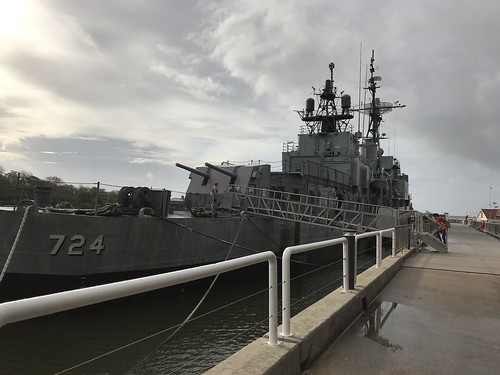
Patriots Point USS Laffey Destroyer
USS Clamagore Submarine
This submarine was commissioned at the end of World War II and underwent numerous internal and external modifications to keep its technology current. The Clamagore was one of nine boats to be converted to a GUPPY III and the only surviving GUPPY III submarine. It has been on display at Patriots Point since 1981.
On a hot day, I recommend walking through this submarine early in the day.
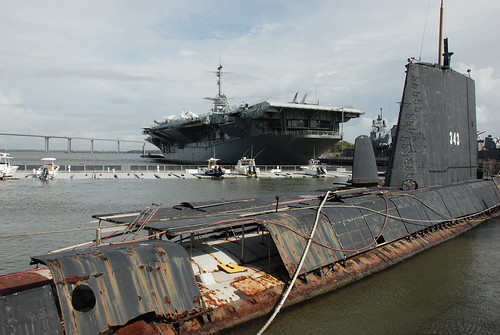
Patriots Point Clamagore Submarine and USS Yorktown
Vietnam Experience
After touring three regions in Vietnam, I didn’t anticipate visiting an American exhibit that focused on the Vietnam War experience in Charleston. An online search revealed that this site houses the first American exhibit to honor Vietnam War troops.
Our initial intention was to explore the dozens of outdoor exhibits simulating American soldiers’ life in the 1960s. Relics from the war—patrol boats, choppers, artillery, and others—are effectively positioned on the 2½-acre site to recreate a Brown Water Navy base and a Marine base at Khe Sanh in 1968 during the Tet Offensive.
While I’ve never been in a war zone, the sound effects appeared realistic. To escape the pelting rainstorm, we headed inside a Quonset hut where a short movie was playing.

Patriots Point Inside Quonset Hut at Vietnam Experience
RECAP OF CHARLESTON VISIT
There is little doubt that history comes alive in Charleston. While I concentrated my efforts on exploring a handful of historical sites, others can simply walk down the cobblestone streets to admire 18th and 19th century architecture or dine at remarkable restaurants that share generations of Lowcountry cuisine.
While strolling through the grounds of the Magnolia Plantation and Drayton Hall, I developed a better understanding of the implications of slavery on the pre and postwar economy and the lifestyle of the region. At the other historical sites, I embraced the region’s culture by learning about significant events and personalities. A visit to Charleston promotes an engaging connection to the past that cannot be duplicated by reading a book or watching a movie.
Sandy Bornstein, the History Comes Alive Through Travel Editor for Wandering Educators, has visited more than 40 countries and lived as an international teacher in Bangalore, India. Sandy’s award-winning book, May This Be the Best Year of Your Life, is a resource for people contemplating an expat lifestyle and living outside their comfort zone. Sandy writes about Jewish culture and history, historical sites, family, intergenerational, and active midlife adventures highlighting land and water experiences.
Disclosure: The author’s multi-day visit to Charleston and Mt. Pleasant was hosted by Explore Charleston.
All photos courtesy and copyright the Traveling Bornsteins, except where noted.
